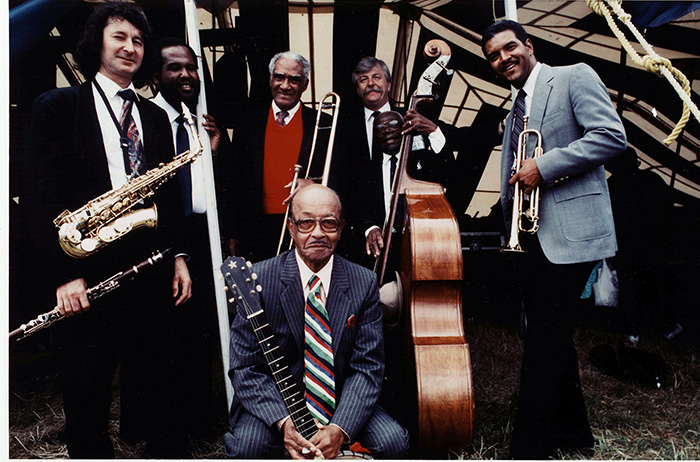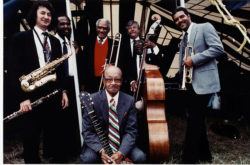Syndey Byrd
South Louisiana's musical traditions and Carnival celebrations fueled photographer Syndey Byrd's work for more than thirty years.

Courtesy of Louisiana State Museum
Louis Nelson and the Big Six. Byrd, Syndey (Photographer)
Syndey Byrd was a prolific photographer who documented the distinct cultural practices of New Orleans and south Louisiana from the 1970s through the early 2010s. South Louisiana’s musical traditions and Carnival celebrations have fueled Byrd’s work: from elite society balls and krewe parades to the Mardi Gras Indians and the ever-changing street theater of the Vieux Carré on Fat Tuesday, she has seen and photographed it all. Art critic D. Eric Bookhardt once offered the observation that Byrd is “perhaps the most tenacious and prolific of Mardi Gras photographers.”
Born in Hattiesburg, Mississippi, on July 3, 1944, Byrd attended the University of Mississippi in Oxford, where she studied painting. Following college she moved to New York City, where she remained for five years before she left the city and traveled throughout the United States and Canada in her car, enlarging her view of the world with its different cultures and traditions. She moved to New Orleans in the mid-1970s, and the city has remained her base ever since. Byrd marks a shift in her thinking about photography to 1976, when she met photographer Ernst Haas, considered one of the great masters of color photography. She describes her contact with Haas as a decade-long apprenticeship, where the older photographer critiqued and advised her on photographic issues in her work, in her words, “helping me shape the emerging body of my New Orleans imagery into an aesthetic and documentary whole.”
Byrd’s New Orleans pictures do not start or end with Mardi Gras. The city’s musicians and events that showcase them are part of her pursuit to define a cultural mosaic of her adopted city. Portraits of musicians in their homes and at work form a significant element of her work: Ernie K-Doe, Antoine “Fats” Domino, and the Neville Brothers are among her well-known subjects. She has also marked the passing of many musical giants of New Orleans by photographing their funerals.
In addition to the full panoply of New Orleans’s Carnival celebrations, Byrd has participated in and documented the traditional Cajun courir de Mardi Gras in rural Acadiana, a ritualized group horseback ride whose purpose is to gather ingredients for a communal gumbo. For those accustomed to the tightly packed streets of urban carnival, the sight of a single costumed and masked rider against a backdrop of a wintry field is startling and somewhat surreal.
For much of her career, Byrd has used her vision to explore parallels of New Orleans culture to that of Haiti. Since its founding in 1718, New Orleans has shared much with Haiti, which gained independence from France in 1804. Byrd’s images of Haitian cultural rituals, architecture, and street life emphasize the visual similarities between the two places that have persisted through the centuries.
Byrd’s work has been the focus of exhibitions in the United States and abroad. Large solo exhibitions in 1992 were held at the New Orleans Museum of Art and the Mardi Gras Museum in Kenner, Louisiana. A group exhibition, ¡Carnaval!,addressing the holiday’s traditions around the world, included her work. Between 2004 and 2007 the exhibition was shown in Santa Fe, New Mexico; Los Angeles, California; Dallas, Texas; New Orleans; and New York City. A solo exhibition was held in Paris in 2007, and an exhibition at the New England School of Photography in Boston, Massachusetts, was mounted in 2009. Byrd’s work is in the collections of the Louisiana State Museum, the New Orleans Museum of Art, the Mardi Gras Museum, and the Amoco corporate collection. She was one of eight photographers featured in the 1992 Public Broadcasting System program about documentary photographers, Ten Thousand Eyes.
The excellence of Byrd’s work has been recognized by first place awards from the New Orleans Press Club in 2001 and 2008 for her photo stories in Louisiana Cultural Vistas magazine. In 2002 the New Orleans Musicians Clinic conferred upon her its Blue Lu and Danny Barker Keeping the Music Alive award. In 2009, The Backsteppers, a photographer-based club started in the manner of traditional New Orleans social aid and pleasure clubs, named her Queen for Life. Additional recognition came in 2010, when she received the Louisiana Endowment for the Humanities’ Michael P. Smith Award for Documentary Photography.
Byrd was diagnosed with Alzheimer’s disease in 2012 and was admitted to an assisted-living facility shortly thereafter. In April 2015 the New Orleans Jazz and Heritage Festival mounted a retrospective of her works but Byrd was unable to attend. She died later that year on October 1 at the age of 71.
